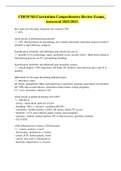CDEM M4 Curriculum Comprehensive Review Exams_
Answered 2022/2023.
how many pts with aortic dissection have normal CXR?
✅- 40%
initial actions in abdominal pain patients?
✅- UPT, blood products for hemorrhage, abx, bedside ultrasound, immediate surgical consult if
unstable or rigid abdomen, analgesia
hemodynamic instability and abdominal pain should alert you to...
✅- possible AAA, hemorrhage, sepsis, perforated viscus, necrotic bowel - think bowel edema or
fluid placing pressure on IVC and splinting breathing
hemodynamic instability and abdominal pain immediate actions...
✅- consult surgery, 2 PIV large bores, NS bolus, O2, monitors, type and cross (give type O if
needed)
differential for life/organ threatening abdominal pain:
✅- Infectious: sepsis
GI: biliary, appendicitis, SBO, perforated bowel, mesenteric ischemia, pancreatitis, diverticulitis
GU: PID, tubo-ovarian abscess, testicular/ovarian torsion, ectopic pregnancy
CV: AAA, dissection, schemia, CAS
initial actions in patient presenting with AMS?
✅- ABCDE-G:
- airway: visual check, pulse O2, O2 prn
- breathing - RR (i.e. narcan?), ventilation (BVM?)
- circulation - rhythm monitor vs EKG, BP, pulses, fluids, PIV access
- disability - GCS, neuro deficits, pupils, trauma, pain (imaging?)
- exposure - undress, trauma, patches, PIC or dialysis access, petechiae, bruising
- GLUCOSE
AMS differential for: Primary CNS/Structural
✅- - tumors: primary vs mets
- hemorrahge: spontaneous vs trauma
- edema: HTN, hydrocephalus, tumor
- seizure: post-ictal vs todd paralysis
- dementia: degenerative vs vascular
,AMS differential for: Metabolic/autoregulatory
✅- - high/low: glucose, sodium, calcium, thyroid, temperature
- hypercarbia - poor ventilation?
- hypoxemia
AMS differential for: pharm/toxic
✅- - Meds: HTN, anti/pro-epileptics, overdose, sedatives, opiods, TCA, anticholinergics,
polypharmacy, steroids, sleep aids, tylenol
- Toxins: ETOH, methanol (WWF) vs ethylene glycol (antifreeze)
- Illicit drug use
- Withdrawal: benzos, cocaine, ETOH, opiods
AMS differential for: infectious
✅- CNS: meningitis, encephalitis, abscess (viral vs bacterial...)
Other: UTI, pneumonia, cellulitis, GI,
AMS differential for: CV
✅- hemorrhagic, cardiogenic, hypovolemic, distributive, anaphylaxis
AMS differential for: psych
✅- migraine, psych dx, psychosis, psychosomatic
mnemonic for AMS
✅- AEIOU TIPS
A: alcohol
E: ethylene glycol, epilepsy, encephalopathy
I: insulin
O: opiates, O2
U: uremia
T: temp, TCA, trauma
I: infecious
P: poisons, psychogenic
S: sex (TSS vs PID), stroke, subarachnoid, space lesions
petechiae differential; labs?
✅- low plts, meninococcemia, emesis, ITP, HTP, HSP, DRESS
Rocky Mountain spotted fever,
,Labs: CBC with diff, retic count, smear, Ig levels, HIV, Hep C, H. pylori, LFTs,
antiphospholipid Abs, SLE serology,
Diagnostic testing to consider for AMS
✅- No shotgun orders unless absolutely necessary:
- Met/Endo - fingerstick glucose, BMP (Na, Ca, BUN, Cr), ABG/VGB, TSH, T4, ammonia,
cortisol
- Meds/toxins - serum osmolality, ETOH, drug screen, drug levels (i.e. antiepileptics)
- CBC w/ diff, UA, UC, BC, LP
- CXR, CT head/spine, MRI, EEG
- Cardiac: ECG, trops, cardiac echo, carotid/vertebral US
vasogenic edema from CNS lesions. give
✅- glucocorticoids
what are the goals of BLS primary survey?
✅- support or restore early oxygenation, ventilation, and circulation until you get a return of
spontaneous circulation or until ACLS can be initiated
T/F patients with shockable rhythm and in desperate need for intubation should be intubated first
✅- F: pts with shockable rhythm should be defibrillated without delay
What consists ABC of ACLS?
✅- Airway - jaw thrust, oropharyngeal or nasopharyngeal airways, or intubation
Breathing - auscultation of lung sounds, ETCO2, CZR, etc.
Circulation - IV/IO access
What drugs are safe for ET administration? What dosage shuold be used?
✅- NAVEL
Naloxone, atropine, vasopressin, epinephrine, lidocaine
2-2.5 times the IV route dosage
ACLS recommends that compressions should be interrupted for...
✅- ventilation, rhythm checks, and shock delivery
after how many minutes of resuscitation with BLS and ACLS is it okay to cesate?
✅- 20 minutes of unsuccessful rescucustation - studies have shown that resuscitation efforts are
unlikely to be successful
what are the two shockable rhythms? ✅- V fib and V-tach
, you see a patient with cardiac arrest. what should you do first?
✅- 1) shout for help, activate emergency response
2) start CPR
3) give O2, attack monitors and defibrillator
4) determine whether rhythm is shockable (VF/VT) or not (asystole or PEA)
you see a patient with cardiac arrest, initiate CPR, and determine has shockable rhythm. What
are the next few steps?
✅- 1) shock immediately w/o delay
2) Give CPR 2 minutes while you obtain IO/IV access
3) determine rhythm again
4) repeat if still shockable rhythm starting epinephrine 1 mg q3-5m IV/IO, consider advanced
airway
5)continue algorithm until develops ROSC or non-shockable rhythm
you see patient with shockable rhythm, received CPR, 3x defibrillations, and epinephrine q2-
q5m, and got LMA and continues to have a shockable rhythm. What additional step do you take?
✅- - Continue CPR, shocks, and epineprhine q2-5m
- Add antiarrhythmics: amiodarone 300 mg bolus, 150 every 2 shocks until no longer has
shockable rhythm, or lidocaine 1-1.5 mg/kg bolus, then 0.5-0.75 mg/kg q5-10m
you see a pt in cardiac arrest, obtain help, start CPR and determine they have a non-shockable
rhythm. What are your next steps?
✅- - Continue CPR
- Establish IV/IO access
- Administer Epinephrine 1 mg q2-5m
- Consider advanced airway
- Check if they have shockable rhythm
- Treat reversible causes
you see a pt in cardiac arrest, start CPR, and determine they have shockable rhythm. You initiate
the algorithm and determine they V-tach developed into Torsades de Pointes. In addition to the
normal shockable algorithm. What medication can you administer?
✅- Magnesium 1-2 g (in 10 mL of D5W) bolus, then 0.5-1 g/hr
in ACLS, what mediation can you substitute once for epinephrine
✅- 40 U of vasopressin
you see a pt in cardiac arrest without shockable rhythm, start CPR, and epinephrine q2-5m. In
addition to aforementioned a`lgorithm, what medication should you consider in PEA or asytole?
✅- 1 mg atropine IV/IO q3-5m x3 doses




